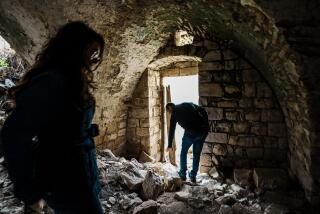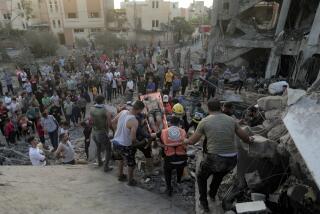Two Syrian towns once lived peacefully alongside neighbors. Three years under siege changed everything
One morning last month, the residents of Fuah and Kfarya got word that it was time to leave.
“I didn’t believe it at first,” said Jamal Faour, 33, who works for the Syrian army as a photographer. “We no longer believed anything.”
For more than three years, the towns — whose residents support the government — have lived under a siege imposed by rebels in Idlib province fighting to topple Syrian President Bashar Assad. Evacuations had been promised before, only to be called off.
But on July 18, a total of 121 buses pulled into Fuah and Kfarya. The 6,900 townsfolk, carrying little more than suitcases, crammed onboard.
As the convoy trundled through rebel-held territory, people on the sides of the streets lobbed rocks and shoes.
When the ragged evacuees finally reached Al Eis, the last rebel-controlled area before entering the government-held city of Aleppo, an Al Qaeda member carrying an AK-47 entered one bus and launched into a tirade.
“You have no place in Idlib, you rawafidh!” Abu al Yaqthan al Masri shouted in a scene captured on video and posted on social media by pro-rebel outlets.
The term he used is a slur against Shiite Muslims — and it was a telling indication of the division wrought by seven years of civil war.
The conflict started as part of the “Arab Spring” movement pushing for democratic reform across the region. But it morphed into a sectarian conflict as outside powers got involved and turned Syria into a microcosm of the region’s politics and religious strife.
Fuah and Kfarya became trapped in the middle.
Most of the 40,000 residents were Shiites, which made them a minority in their predominantly Sunni province. Before the war, the religious differences never amounted to much.
“They would marry from our families, we would marry from theirs,” recalled Faour, who lived in Fuah but worked as a computer teacher in the nearby Sunni-dominated city of Binnish.
But after so long under siege — their residents used as bargaining chips in the battle between Assad and the myriad groups trying to overthrow him — the two towns are deeply and painfully divided from the communities surrounding them.
In peace, members of Assad’s Alawite sect — an offshoot of Shiite Islam — had a significant presence in Syria’s security and intelligence service. But much of the governance and major business interests remained in the hands of the Sunni majority, 74% of the population.
In war, Sunni-dominated Saudi Arabia, Turkey and Qatar bankrolled hard-line groups that became the vanguard of the opposition and attracted jihadis from around the world. Shiite-dominated Iran, meanwhile, dispatched paramilitaries from Lebanon, Iraq and Afghanistan to bolster government troops.
Whereas Idlib and other parts of northern Syria became bastions for anti-Assad forces, Fuah and Kfarya remained firmly under government control. Many residents enlisted in “popular committees,” citizen brigades that were trained and funded by Iran and the Lebanese Shiite party and armed group Hezbollah.
The split between the towns and the neighboring communities deepened in 2015, when the Army of Conquest, an alliance of Al Qaeda and other hard-line Sunni groups, drove government troops from most of Idlib and encircled Fuah and Kfarya.
The rebels — using a “starve and surrender” tactic the government had long employed — vowed to massacre the 17,000 Shiites still there.
Across pro-government areas in Syria, protests spread demanding the civilians of Fuah and Kfarya be saved.
Iran brokered a solution that fall, after Hezbollah mounted its own siege on the rebel-held Damascus suburbs of Zabadani and Madaya, both of which are predominantly Sunni.
Working with Turkish and Qatari intermediaries, Iranian officials held a secret meeting in Istanbul with representatives from the Army of Conquest. United Nations officials were there as observers, according to a high-placed Western humanitarian worker in Syria. There was no Syrian government presence.
The deal was known as the Four Towns Agreement. The Army of Conquest agreed to spare Fuah and Kfarya. In exchange, Hezbollah agreed to spare Zabadani and Madaya.
And going forward, the number of people allowed to leave one set of towns — and the amount of aid going in — would be matched in the other set.
The Syrian government began sending 20 planes every month over Fuah and Kfarya to drop bread, fuel, ammunition and other supplies. But the deliveries were never enough. The U.N. described the situation in the besieged towns as “catastrophic,” with civilians “trapped in a cycle of daily violence and deprivation.”
As the government shut down rebel enclaves across the country, it granted the militants safe passage to rebel-held areas of Idlib, sometimes in exchange for the evacuation of civilians in Fuah and Kfarya.
The transfer deals often went awry, buffeting those civilians between the threat of death at the hand of the jihadis and the promise of evacuation or a government advance that would break the siege.
One deal, brokered by Qatar in 2017, was supposed to evacuate all four towns. But a suspected rebel car bomb killed more than 100 residents from Fuah and Kfarya as they were about to enter government-held areas.
Many had given up hope of ever leaving, according to Zain Abideen Taleb, a 54-year-old lawyer. After his wife and their ill child left as part of a swap in 2016, he told her that he probably would never see her again and she should assume he would die fighting.
“We watched all these rebels leave in Homs, Aleppo, Zabadani, Madaya and Ghouta,” Taleb said, listing the names of onetime rebel enclaves. “The militants were always calling us hostages, a government weak spot they wouldn’t give up at any price.”
Last month, the Sunni jihadis began to mass for a large attack on Fuah and Kfarya.
The impending offensive was the impetus for a deal to evacuate the two towns, according to a jihadi commander in a video interview with pro-opposition outlet Zaman al Wasl.
“The Iranians communicated with us and said they would exchange 1,500 people in regime prisons and some of the jihadi warriors,” said the commander, who used the nom de guerre Abu Abed.
On the day of the evacuation , when the buses finally began rolling away, the dominant emotion in the towns was relief.
“Does anyone leave their house, memories and land and be happy?” Taleb said. “But it got to the point where we wished to go.”

In the aftermath of the evacuation, the jihadis blitzed into the towns. They looted, desecrated Shiite shrines and welcomed Sunnis who had been displaced by government campaigns.
They renamed the towns for two caliphs revered by Sunnis: Farooq and Siddiq.
The evacuation placed all of Idlib in the hands of the anti-government forces. But it also cleared the way for the Syrian government and its Iranian and Russian allies to launch an assault on the province in hopes of taking it back and consolidating power in the country’s northwest.
That has given the former residents of Fuah and Kfarya — who are scattered across Syria — hope that they might soon return and rebuild their lives.
Taleb and his 48-year-old brother, Yahya, said they would have no trouble living near Sunnis in Idlib.
“Things will return as they were…. In any society where you have bad people in control this is what will happen,” Yahya said by phone.
But Mohammad Hassan Taqi, a Fuah resident who had headed the towns’ crisis committee, was less certain.
“We’ll get the towns back, but living there will be almost impossible,” he said.
“There were victims … there will be revenge. It will be 10 years until things go back to as they were.”
Twitter: @nabihbulos
More to Read
Start your day right
Sign up for Essential California for news, features and recommendations from the L.A. Times and beyond in your inbox six days a week.
You may occasionally receive promotional content from the Los Angeles Times.







